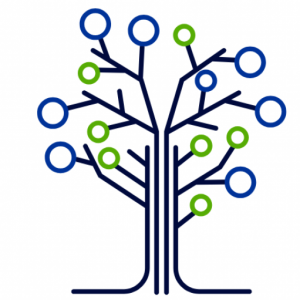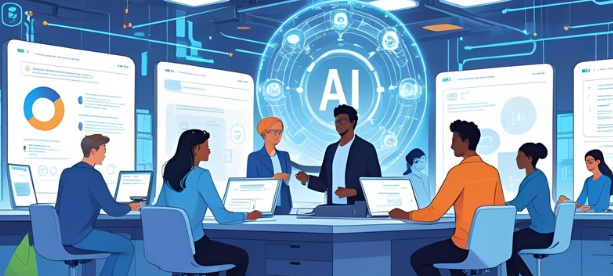We’ll learn about
- Data-Driven AI
- Algorithm
We’re going to look
- Data
- Networks
- Algorithms
Eg-Starbucks
Reason for its success is a critical focus on customer experience.
They really care about their customers’ experience.
They’ve built customer experience in the digital world through their app.
The app collects the customer data and all this data tells them about customer preferences.
What is AI?
To know this, we need to first understand the Turing Test. The test was first proposed by Alan Turing, in this test, a human evaluator interacts with a machine and a human through text-based communication, typically in separate rooms, without knowing which is which. If the evaluator cannot distinguish b/w the human and the machine, then it means that machine has passed the Turing Test.
It is also known as the Imitation Game.
AI- Systems that perform actions that if performed by humans would be considered intelligent. – By John McCarthy the Father of AI
What is Rule-Based AI and Data-driven AI?
Rule Based AI
It follows a set of fixed rules written by humans.
If something matches those rules, it acts.
Eg-
Home Automation Systems:
Turning on lights if it gets dark or turning off AC if the temp goes.
below 20 degrees off.
Data Driven AI
It learns from examples and data instead of fixed rules.
It finds patterns and improves by itself.
Eg-
Self Driving Cars:
Learning to recognize objects like pedestrians or stop signs by analyzing millions of real world driving scenarios.
A system learns to recognize cats by analyzing 1000s of cat photos.
Data Driven AI needs data.
Where does the data come from?
For starters, it comes from the device we use all day, smartphones. Popular Apps are Facebook, Instagram, messenger, snapchat, G-mail.
What is common in all these apps?
That these apps allow us to connect with other humans.
Eg- There are many streaming platforms like Netflix, and they are all digital.
It collects data about your viewing habits.
It’s AI identifies patterns:
-What genres you like ( comedy thrills).
-Who are your favourite directors or actors?
-The time of day you watch.
Based on these patterns, Netflix suggests shows or movies.
Role of AI (Rule-Based v/s Data-driven)
Rule-Based AI: In the past, Netflix might have used fixed rulers like “If someone watches a comedy, it recommends other comedy shows.”
Data-Driven AI: Now, Netflix uses machine learning to analyze millions of user interactions and customize recommendations based on what people with similar preferences liked.
This smart use of AI is why Netflix feels like “it knows you” so well!
How Google images came out?
To know this, we have to start with ImageNet.
It was a project that was started by Fei-fei-Li at the University of Illinois. Her idea was to do image classification. She needed millions of labeled images to help computers to learn to recognize objects, but no database existed back then.
What did she do?
- She used crowdsourcing.
She turned to Amazon Mechanical Turk, a platform where people from around the world can do small tasks for money.
Then she asked these workers to label images by identifying objects like, whether an image showed a cat, car or apple.
- She organized the images:-
She used a tool called Word Net to create clear categories for the images like “Animals” or vehicles”.
- She ensured quality:-
To make sure the label’s were correct, multiple workers looked at the same image and their answers were cross-checked.
The Result:
Thanks to her smart use of crowdsourcing & organization, she built Image Net, a huge dataset that changed how AI learns to see. It made advanced technologies like Facial recognition & self-driving cars possible.
What is Machine Learning in AI?
It is a part of AI that allows computers to learn from data instead of being programmed with fixed rules.
movies.
Eg-
Netflix recommendations: Learn what you like and suggest movies.
Spam Filters: Learn to detect and block spam emails.
And deep learning is also an example of machine learning that is a little more advanced than is probably used in more advanced things like the Jeopardy.
What is jeopardy?
It is a popular American TV quiz show where contestants are given clues in the form of answers, and they must respond with the correct question.
Commonality b/w Machine Learning & Statistics
Both the following words have the same meaning.
Machine Learning
- Learning
Statistics
1. Estimation Fitting:- It is about finding the best way to represent data using equations or models.
Eg-You want to guess how much a pizza will cost based on its size?
Then you got to know that A 6 inch pizza costs Rs. 600.
A 12 inch pizza costs Rs.1200.
You noticed that as the size doubles, the price also doubles.
2. Hypothesis Testing
2. Confirmatory Data Analysis:- It is method used to test whether a hypothesis (assumption) about datais true or not.
Eg- Checking if a new ad campaign really increases sales as predicted.
3. Instance
3. Data Point:- It is a single piece of info. in a dataset.
It represents one specific value in the collection of data.
Eg- If you’re tracking your daily step count for a week:
Mon- 5000 Steps,
Tue- 6200 steps
Wed- 7000 steps.
Each of these numbers is a data point in your dataset.
4. Weights
4. Parameter:- It is a fixed value that describes something about a whole population in statistics or helps to define a mathematical model.
Eg- If the govt records say India has 1.4 billion people, that number is a parameter (because it’s a fixed number for the entire population).
5. Supervised Learning
5. Regression / Classification:-
Regression predicts numbers
(How much, How many)
Eg- How much will a house cost?
Rs. 50L, 60L,75L (continuous numbers)
Classification predicts categories
(Which one? Yes/No?)
Eg- Is this email spam?
yes / No (fixed categories)
6. Unsupervised learning
6. Clustering:-It is used to group similar data points together without knowing the categories beforehand.
Eg- Google News – Google groups similar news articles together. Like politics, sports, tech-etc.
Types of Clustering Algorithms-
- K-means: most popular divided data into K groups
- Hierarchical : creates a tree-like structure of clusters.
- DBSCAN:- groups based on density.
8. Label
8. Response:- It is the outcome or the result that you are trying to measure or predict. It is the variable that changes based on other factors or variables.
Eg- In an experiment to see how study time affects exam scores, the response is the exam score because
It’s what you’re measuring to see how it changes based on study time.
What are the Different types of Machine Learning?
There are 4 ways
- Regression
- Dimensionality Reduction
- Classification
- Clustering
So, we’re going to use an example of AirBnb to understand how a company like that would use each of these 4 different types of ML (Machine Learning) for different objectives.
1. Regression – It is used to predict a continuous value.
Airbnb might use regression to predict sales of property based on things like the number of rooms, location or time of year OR how much property would be rented out.
And to predict it, it might use independent variables like the features of the property.
2. Dimensionality Reduction – It is used to turn all messy data, unstructured data into numeric values or structured data.
Airbnb has data on many features (like location, reviews, price. amenities etc), dimensionality reduction can help to simplify the date So, it’s easier to analyze or visualize. It helps in focusing on the most imp. factors that affect customer choices or predictions.
3. Classification – It is used when we want to sort data into categories or classes.
We put images of all the properties on Airbnb. We might be putting the images of Bathroom, Kitchen, Bedroom etc.
Now sometimes we classify them right and sometimes we forget to classify them. Wouldn’t it be nice for AIRBNB to have a classification algorithm to take all these images and automatically say, hey, I recognize that’s a Kitchen, Bedroom etc. and then it classifies it automatically for us and makes the experience of hosts to put the images of their property much simpler.
4. Clustering– It groups similar items together. It’s like. sorting things into different categories on their similarities.
AirBnb might use clustering to group similar types of properties together like budget friendly or luxury properties.
This helps them to understand what types of properties are popular in certain areas or what kind of guests prefer certain features.
What is Deep learning?
Deep Learning is a super smart machine learning technique that helps computers to do difficult tasks like:-
- Recognizing faces in photos
- Understanding speech (like Alexa or Siri)
- Even driving cars
(This is like a smart human brain– it learns from experience, improves over time and can make powerful decisions with enough training.)
How does Deep Learning work?
Deep Learning is built on neural networks-which are like the brain of a machine. Think of a neural like a grilled cheese sandwich:
–Two slices of bread (input & output layers): The input layer takes in the data, and the output layer gives the final result.
-Cheese Hidden layers in between: These hidden layers process the data and help to make smart decisions.
How is Deep Learning Different?
Now, imagine a burger instead of a grilled cheese:
-Instead of just one layer of cheese, a burger has multiple layers– cheese, lettuce, tomato, patty, sauces etc
-Similarly, deep learning has many hidden layers that help it to understand data in a more advanced way.
Why do we need Deep Learning?
Regular machine learning works fine for simpler problems. But for really complex things-like telling a cat for a dog in a picture or predicting stock prices – deep learning is better because it can learn patterns on its own, even from huge amounts of data.




